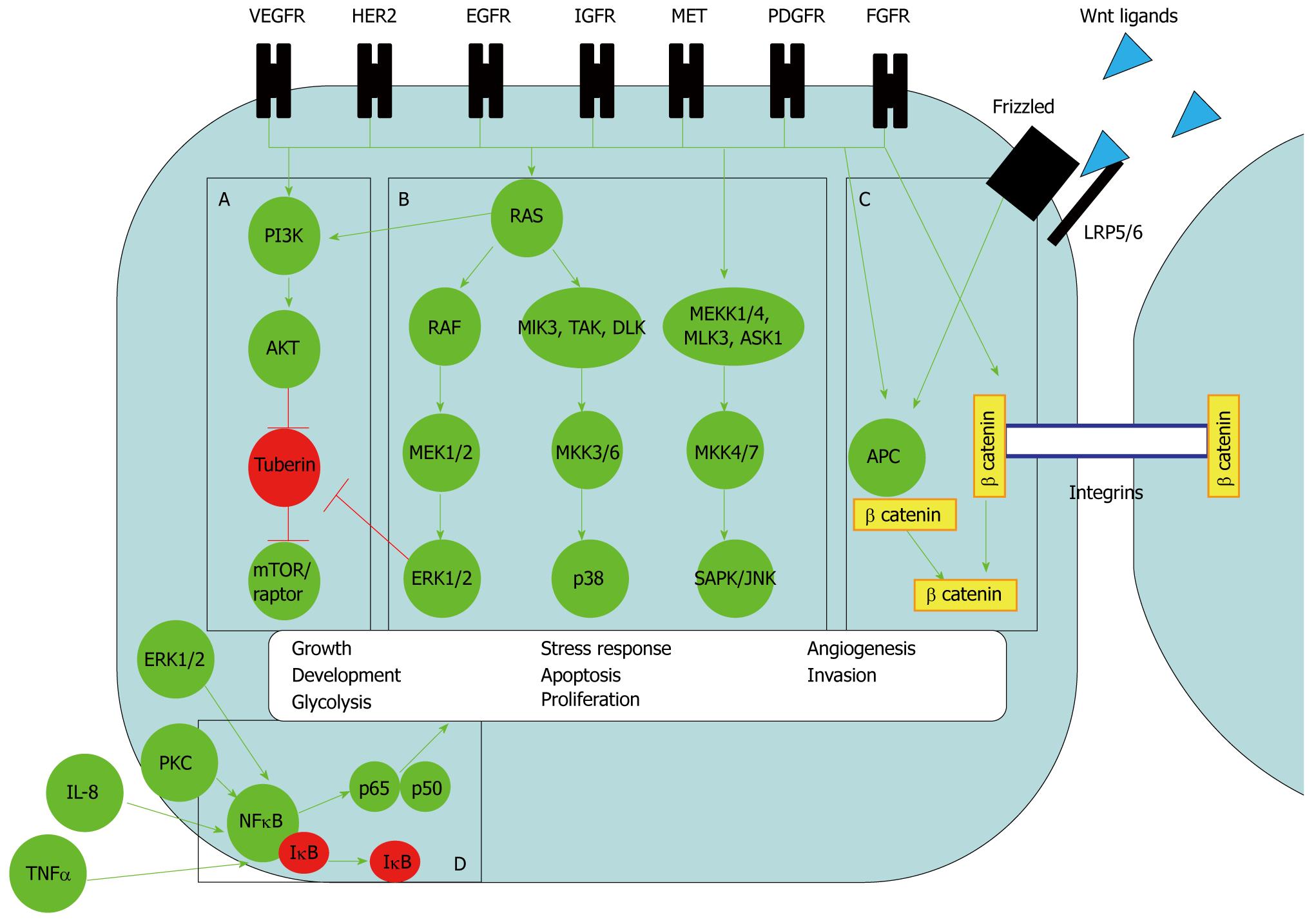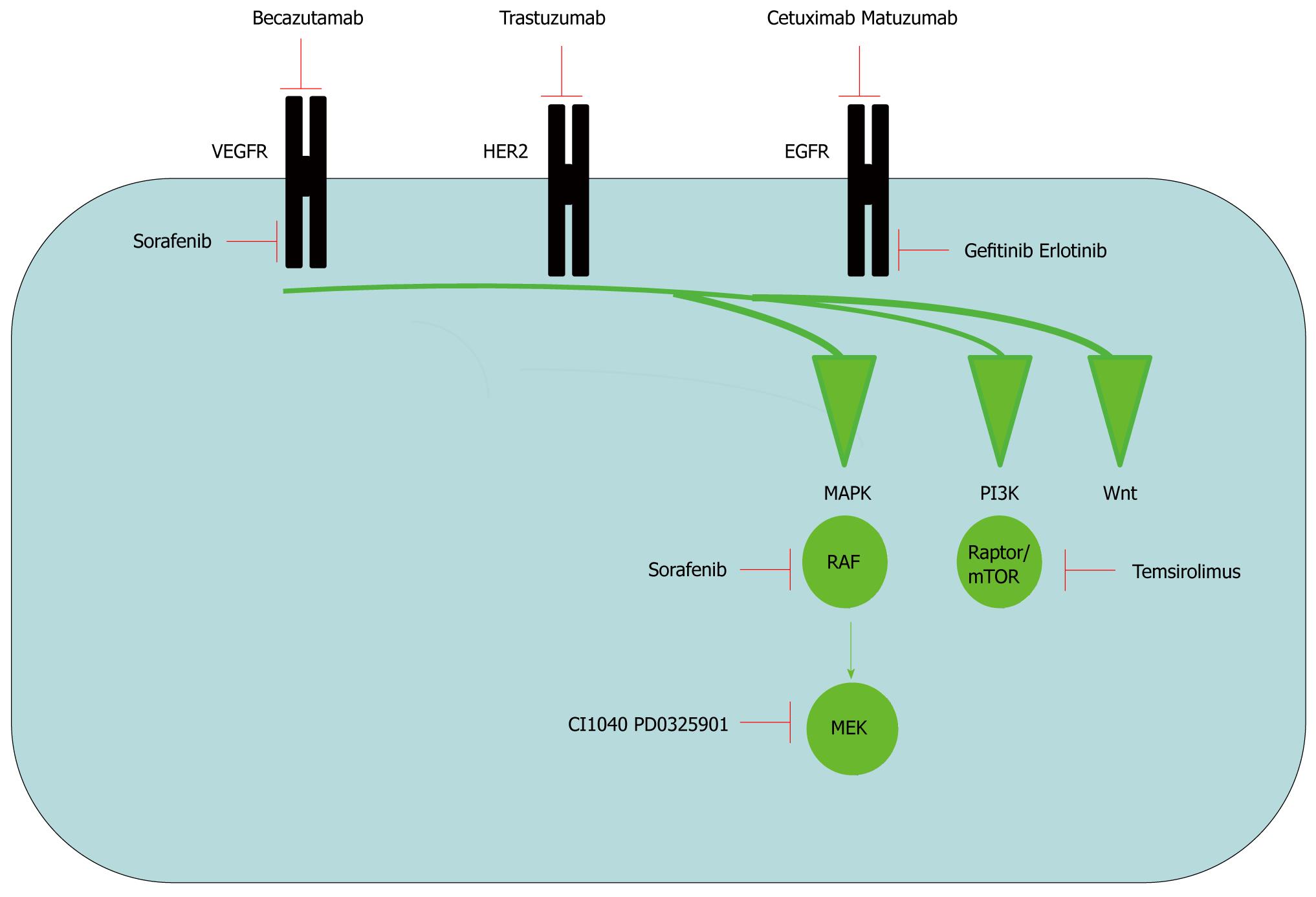Copyright
©2011 Baishideng Publishing Group Co.
World J Gastroenterol. Jun 21, 2011; 17(23): 2781-2790
Published online Jun 21, 2011. doi: 10.3748/wjg.v17.i23.2781
Published online Jun 21, 2011. doi: 10.3748/wjg.v17.i23.2781
Figure 1 Signalling pathways in oesophageal adenocarcinoma.
The pathways known to be operative in oesophageal adenocarcinoma are A: PI3-Kinase, B: Mitogen activated protein (MAP) Kinase, C: Wnt signalling and D: Nuclear factor-κB (NF-κB). The green arrows indicate activation, the red arrows indicate inhibition. Vascular epidermal growth factor (VEGF), human epidermal growth factor receptor 2 (HER2), epidermal growth factor receptor 1 (EGFR), insulin growth factor receptor (IGFR), hepatocyte growth factor receptor (MET), platelet derived growth factor receptor (PDGFR) and fibroblast growth factor receptor (FGFR) are the known receptor tyrosine kinase (RTK) associated with oesophageal adenocarcinomas. The pathways are complex and inter-connected. For example RTKs can activate all 4 known pathways. The ultimate biological response varies from cell proliferation, development, apoptosis, differentiation, inflammatory response, angiogenesis and invasion depending on which specific pathway or receptor is activated. A: PI3-Kinase pathway. RTK activates PI3-Kinase directly or through RAS. As a consequence of phosphorylation, PI3K recruits AKT. AKT inhibits tuberin, this allows activation of the Raptor/mTOR complex to activate transcriptional machinery. mTOR/raptor activates transcription factors and co-activator proteins cMyc and hypoxia inducible factor (HIF)-1α that drive the biological response of growth, proliferation, glycolysis, angiogenesis and invasion; B: MAP Kinase pathways. The 3 main MAP Kinase pathways are extracellular related kinase (ERK), p38 and JUN kinase (JNK). They are all activated by similar RTKs. The signalling pathways have a common feature of a cascade of phospho-proteins. A MAPKK Kinase (e.g. RAF), a MAPK Kinase [e.g. MAP ERK kinase (MEK)1/2] and a MAP Kinase (eg. ERK) transfer the signal onto multiple transcription factors on gene promoters[31]. ERK signalling for example can alter the gene expression of over 200 genes[32]. The subsequent biological response varies from cell proliferation, development, apoptosis, differentiation and inflammatory response, depending on the specific pathway activated; C: Wnt signalling. Wnt signalling exerts a biological response through release of β catenin into the nucleus with subsequent action on gene promoters. β catenin is released directly from RTK phosphorylation of Axin. Alternatively Wnt ligands bind to Frizzled receptors and form a complex with the LRP5/6 membrane receptor. The membrane receptor complex recruits dishevelled and axin from a cytoplasmic complex of dishevelled, Axin, adenomatous polyposis coli protein (APC) and β catenin. This allows release of β catenin; D: NF-κB pathway. NF-κB (p65p50) activates gene promoters only when released from IκB. Interleukin-8 (IL-8), tumour necrosis factor (TNF)α and radiation activate the pathway. Adding to complexity, ERK MAP Kinase and Wnt, through protein Kinase C, can also potentially activate NF-κB although this link has not been investigated in oesophageal adenocarcinoma.
Figure 2 Drug inhibition of signalling pathways.
Drugs that target signalling pathways can be divided into two groups. Antibodies [Becazutumab, trastuzumab, cetuximab and matuzumab are antibodies that target the receptor tyrosine kinase (RTK), vascular epidermal growth factor receptor (VEGFR), human epidermal growth factor receptor 2 (HER2) and epidermal growth factor receptor 1 (EGFR) respectively] and small molecular inhibitors (The small molecular inhibitors gefitinib and erlotinib target EGFR. Temsirolimus specifically inhibits the PI3-kinase pathway at the level of Raptor/mTOR. CI1040 and PD0325901 inhibits ERK MAP kinase pathway at the level of MEK. Sorafenib is a dual inhibitor of the VEGF receptor and ERK MAP kinase at the level of RAF).
- Citation: Keld RR, Ang YS. Targeting key signalling pathways in oesophageal adenocarcinoma: A reality for personalised medicine? World J Gastroenterol 2011; 17(23): 2781-2790
- URL: https://www.wjgnet.com/1007-9327/full/v17/i23/2781.htm
- DOI: https://dx.doi.org/10.3748/wjg.v17.i23.2781














